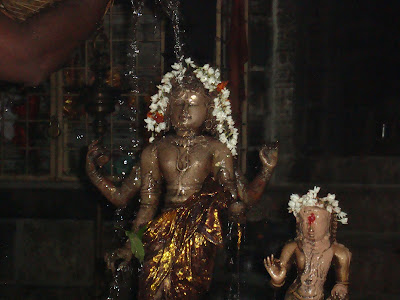

On Margazhi eighth day the
Picchadana will get a special abishega
and alangara then these moorthis get
deeparathana
The theme of Shiva as a beggar is not unique to the Bhikshatana icon and his legends. Shiva is often described as wandering the universe as a homeless beggar-ascetic with his consort Parvati's raison d’être being to bring him back to his marital and home life.Shiva is also depicted as asking for alms from the goddess Annapurna, a form of Parvati as the goddess of food. The Satarudriya describes Shiva as gathering food through begging, evocative of his Bhikshatana form. In spite of this he is described as a sustainer of the universe and of life-sustaining food.
Though Shiva is commonly described as a beggar, the specific theme of the expiatory wandering—which is the core of the Bhikshatana tale—originates uniquely from the ascetic traditions of the
Kapalika sect and its precessor
Pashupata sect.
Bhikshatana mirrors the role of Kapali (skull-bearer), the wandering ascetic who defends himself with a trident and magical powers, holds a skull-bowl, and worships Shiva (the term Kapali also being used to designate a member of the Kapalika sect). Scriptures like the Kurma Purana explicitly identify Shiva with a Kapali – "an outsider who scares by his looks, and sometimes charms" – in this form.
To atone for the sin of severing the god Brahma's fifth head, Shiva is said to have separated the body of Bhairava from his own and sent it to wander with the skull of Brahma in his hand, a vow that parallels the
Maha-vrata ("great vow") that a Kapali must undertake to dispell the sin of accidentally killing a Brahmin. The expiatory wandering punishment of 12 years is also given to a
Bhrunaghna sinner—a learned Brahmin who kills another of great learning and good conduct. The vow is prescribed in the
Dharmashastras, a text corpus detailing ethics and conduct. The sinner should live in an isolated place and beg in only seven houses with the skull of the slain. He must use as a staff the bones of the slain and be treated by society as an outcast. Similarly, Bhikshtana is described as using Brahma's skull as his begging bowl and his bones as a stave. He wandered begging at the seven houses of the
Saptarishi – the seven great sages – and lived in cremation grounds outside a town.
 Kadamba is a fragrant and beautiful solid flower, which is round in shape. The flower especially grows in Vrindavan and Mayapur. Recently, a week ago in Mayapur, sweet fragrance of Kadamba flowers filled the air. As you walk around the campus, Kadamba trees full of beautiful round white flowers like snow balls is a scenic delight. For the divine pleasure of the Lord, devotees lovingly offer Kadamaba garlands and bouquets. Kadamba flowers can be seen only for few days in a year. Krishna enjoys His rasa dance underneath the kadamba tree.
Kadamba is a fragrant and beautiful solid flower, which is round in shape. The flower especially grows in Vrindavan and Mayapur. Recently, a week ago in Mayapur, sweet fragrance of Kadamba flowers filled the air. As you walk around the campus, Kadamba trees full of beautiful round white flowers like snow balls is a scenic delight. For the divine pleasure of the Lord, devotees lovingly offer Kadamaba garlands and bouquets. Kadamba flowers can be seen only for few days in a year. Krishna enjoys His rasa dance underneath the kadamba tree. 







